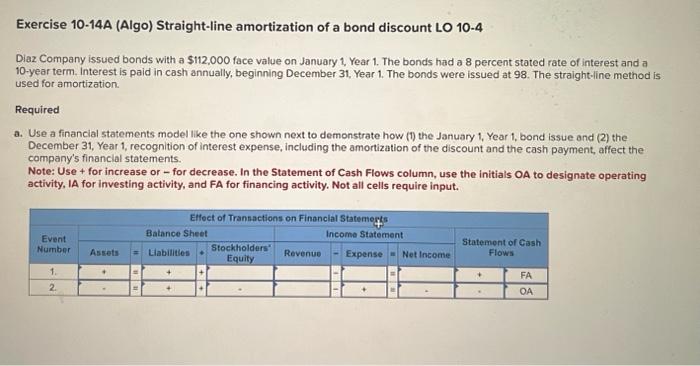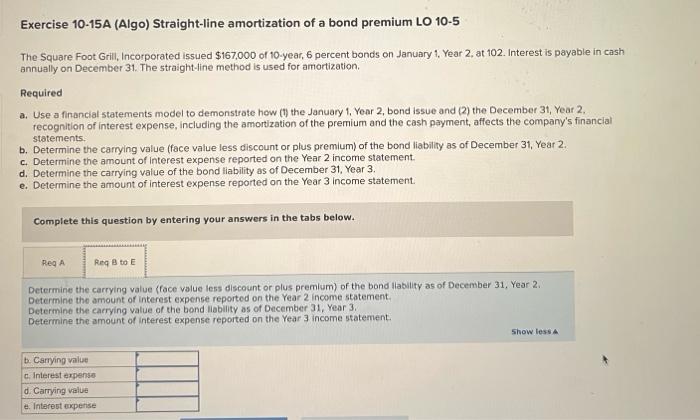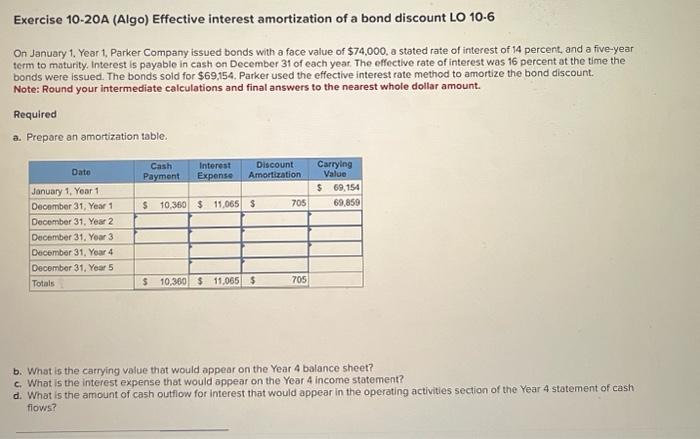Answered step by step
Verified Expert Solution
Question
1 Approved Answer
Exercise 10-14A (Algo) Straight-line amortization of a bond discount LO 10-4 Diaz Company issued bonds with a $112,000 face value on January 1, Year





Exercise 10-14A (Algo) Straight-line amortization of a bond discount LO 10-4 Diaz Company issued bonds with a $112,000 face value on January 1, Year 1. The bonds had a 8 percent stated rate of interest and a 10-year term. Interest is paid in cash annually, beginning December 31, Year 1. The bonds were issued at 98. The straight-line method is used for amortization. Required a. Use a financial statements model like the one shown next to demonstrate how (1) the January 1, Year 1, bond issue and (2) the December 31, Year 1, recognition of interest expense, including the amortization of the discount and the cash payment, affect the company's financial statements. Note: Use + for increase or for decrease. In the Statement of Cash Flows column, use the initials OA to designate operating activity, IA for investing activity, and FA for financing activity. Not all cells require input. Effect of Transactions on Financial Statements Balance Sheet Income Statement Event Number Assets Liabilities Stockholders' Equity Revenue Expense Net Income Statement of Cash Flows 1. + + FA 2. + OA b. Determine the carrying value (face value less discount or plus premium) of the bond liability as of December 31, Year 1. c. Determine the amount of interest expense reported on the Year 1 income statement. d. Determine the carrying value (face value less discount or plus premium) of the bond liability as of December 31, Year 2. e. Determine the amount of interest expense reported on the Year 2 income statement. b. Carrying value $ 109,984 c. Interest expense d. Carrying value $ 110,208 e. Interest expense Exercise 10-15A (Algo) Straight-line amortization of a bond premium LO 10-5 The Square Foot Grill, Incorporated issued $167,000 of 10-year, 6 percent bonds on January 1, Year 2, at 102. Interest is payable in cash annually on December 31. The straight-line method is used for amortization. Required a. Use a financial statements model to demonstrate how (1) the January 1, Year 2, bond issue and (2) the December 31, Year 2. recognition of interest expense, including the amortization of the premium and the cash payment, affects the company's financial statements. b. Determine the carrying value (face value less discount or plus premium) of the bond liability as of December 31, Year 2. c. Determine the amount of interest expense reported on the Year 2 income statement. d. Determine the carrying value of the bond liability as of December 31, Year 3. e. Determine the amount of interest expense reported on the Year 3 income statement. Complete this question by entering your answers in the tabs below. Req A Req B to E Determine the carrying value (face value less discount or plus premium) of the bond liability as of December 31, Year 2.1 Determine the amount of interest expense reported on the Year 2 income statement. Determine the carrying value of the bond liability as of December 31, Year 3. Determine the amount of interest expense reported on the Year 3 income statement. b. Carrying value c. Interest expense d. Carrying value e. Interest expense Show less & Exercise 10-20A (Algo) Effective interest amortization of a bond discount LO 10-6 On January 1, Year 1, Parker Company issued bonds with a face value of $74,000, a stated rate of interest of 14 percent, and a five-year term to maturity. Interest is payable in cash on December 31 of each year. The effective rate of interest was 16 percent at the time the bonds were issued. The bonds sold for $69,154. Parker used the effective interest rate method to amortize the bond discount. Note: Round your intermediate calculations and final answers to the nearest whole dollar amount. Required a. Prepare an amortization table. Cash Date Interest Payment Expense Discount Amortization. Carrying Value January 1, Year 1 December 31, Year 1 December 31, Year 2 $ 69,154 $ 10,360 $ 11,065 $ 705 69,859 December 31, Year 31 December 31, Year 4 December 31, Year 5 Totals $ 10,360 $ 11,065 $ 705 b. What is the carrying value that would appear on the Year 4 balance sheet? c. What is the interest expense that would appear on the Year 4 income statement? d. What is the amount of cash outflow for interest that would appear in the operating activities section of the Year 4 statement of cash flows? b. What is the carrying value that would appear on the Year 4 balance sheet? c. What is the interest expense that would appear on the Year 4 income statement? d. What is the amount of cash outflow for interest that would appear in the operating activities section of the Year 4 statement of cash flows? b. Carrying value c. Interest expense d. Cash outflow for interest
Step by Step Solution
There are 3 Steps involved in it
Step: 1
Here are the answers to the questions a Effect of Transactions ...
Get Instant Access to Expert-Tailored Solutions
See step-by-step solutions with expert insights and AI powered tools for academic success
Step: 2

Step: 3

Ace Your Homework with AI
Get the answers you need in no time with our AI-driven, step-by-step assistance
Get Started


